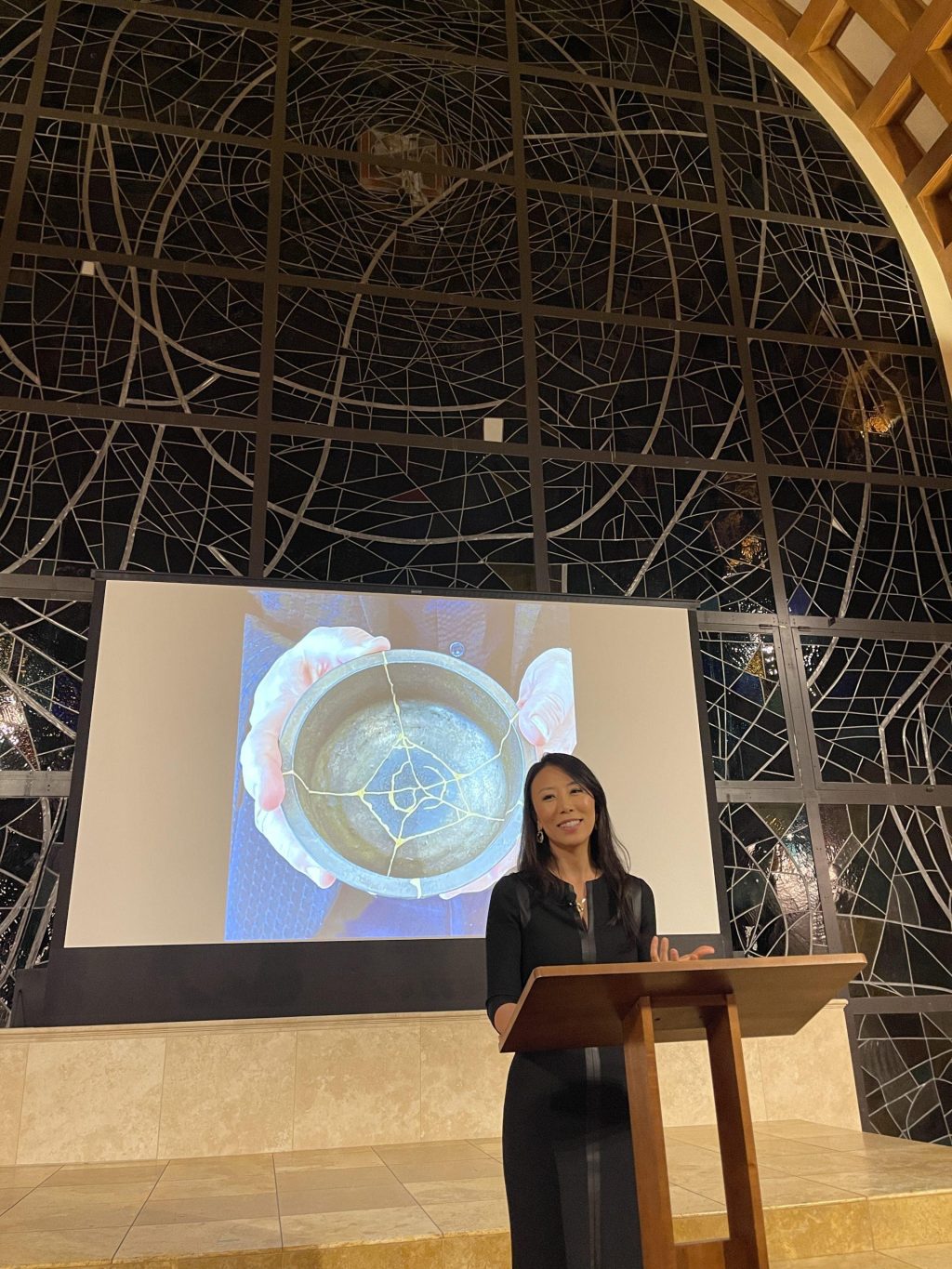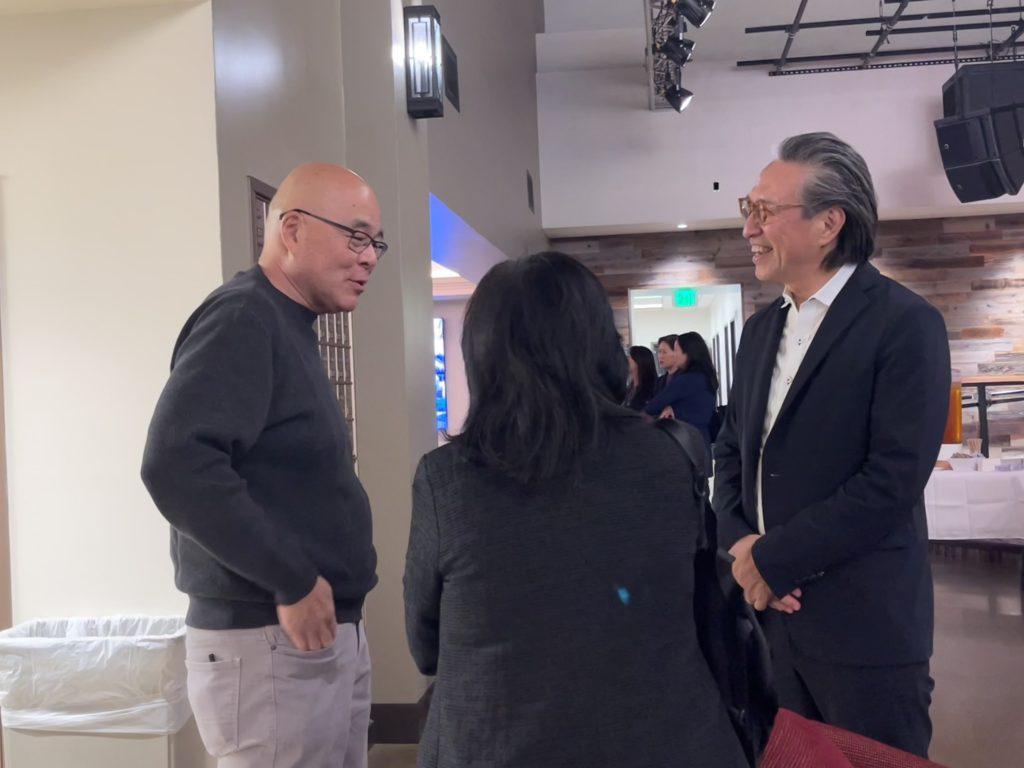
Makoto Fujimura, internationally-renowned artist and writer, and his wife, Haejin Shim Fujimura, lawyer and CEO of global justice organization Embers International, joined the Pepperdine community at Stauffer Chapel on Jan. 18. With the help of the Weisman Museum, they welcomed Makoto Fujimura’s new solo exhibit called “Water Flames.” They both also touched on beauty and justice within their work.
Makoto Fujimura began his talk by emphasizing the word “curator” and how he believes art is a cure.
“That, to me, is one of the significant roles that art can play in this world,” Makoto Fujimura said.
Makoto Fujimura said, through his art, he has been able to speak about the journey of coming out of trauma as a 9/11 survivor.
“My art has a lot to do with that I am a survivor,” Makoto Fujimura said.
Makoto Fujimura said he has continuously asked himself how he can bring beauty and justice into the world with his art.
“I don’t know, except I’m trying to be faithful in what I do,” Makoto Fujimura said.
Makoto Fujimura talked about the journey of trauma and bringing light to it through his art.
Makoto Fujimura discussed the process of one of his pieces called, “Walking on Water Forest.” He said he walked on water to create the painting.
“Part of what I do is to be immersed in this reality of the world around me — nature,” Makoto Fujimura said.
In addition to that piece, he talked about another called “Sea Beyond.” He said he worked on this painting for some time and gained more inspiration for it on a day he went to Newport Beach to pray.
He also read a few paragraphs from his book, “Art and Faith: A Theology of Making.” He described the moment he was watching the horizon at Newport Beach and was told his mother had just passed away, Makoto Fujimura said.
He said, when he went to search “What is Beyond the Horizon?” on Google, he discovered that he was standing facing where his mother had raised him in Kamakura, Japan.
“Almost all the paintings in this exhibit have to do with this reality of facing ground zero and having been traumatized by violence,” Makoto Fujimura said.
Makoto Fujimura said his task is to immerse himself in his art to get through the trauma.
“Choosing to move into those images until the flames of disruption became planes of sanctification,” Makoto Fujimura said.
Beauty and Justice
After Makoto Fujimura’s lecture, Haejin Shim Fujimura spoke about the importance of justice through a religious lens and her work as a lawyer.
“Because God calls himself to be God of justice and righteousness so much throughout the Bible, I had to go into it and look into it,” Haejin Shim Fujimura said.

Haejin Shim Fujimura talked about how she decided to create her own law firm. She said she wanted it to be a place where people could flourish.
“In order to achieve that kind of beautiful world, where God’s justice and righteousness is really played out, we really need to think about not only what we do, why we do it and how we do it,” Haejin Shim Fujimura said.
The event concluded with an 18-minute short film about Makoto Fujimura and Haejin Shim Fujimura’s work in a red-light district in India. Haejin Shim Fujimura said this was a place where she and her team were able to take a former brothel and turn it into a beautiful space to help people in need.
Haejin Shim Fujimura said she and her organization have created a place called “Sahasee Embers.” She said it has become a place where they can educate children born into brothels and empower mothers.
“We imagined toward new creation,” Haejin Shim Fujimura said.
She described the people in the red-light districts as individuals who were living in a dark, dirty and broken place of high human trafficking. She saw tragedy in this area and found people who were willing to make a change alongside her.
“We imagined a beautiful space for children who are born into the brothels,” Haejin Shim Fujimura said.
Attendees Reactions
Many people were in attendance at Stauffer Chapel, including Pepperdine faculty, students and people who have continued to follow Fujimura’s work.
Emma Abernathy, a local attendee from Santa Monica, said she attended the event because she admires Makoto Fujimura’s work.
“It’s full of beauty and justice,” Abernathy said.
Another attendee from Orange County, Tori Cierley, said she follows Makoto Fujimura’s work online and has read one of his books.
“I was really excited to see his work in person,” Cierley said.
Abernathy said she loved the talk Makoto Fujimura gave and appreciates how he incorporates his Christian faith into his art.
“I love how he articulated how the Lord brought him through the trauma, and the trauma is healing, in a sense,” Abernathy said.
Cierley said, in addition to coming to the lecture, she wanted to come see Makoto Fujimura’s exhibit because of his approach to art.
“I’m an artist and a follower of Jesus,” Cierley said. “No one ever talks about those two things together.”
One attendee, Ronald Hazama, said he came to the event because he read one of Makoto Fujimura’s books and previously purchased some of his art prints.

Hazama said learning more about Haejin Shim Fujimura and what she has been doing through her work impressed him.
“Her ministry, her integration of a profession, social justice things and a calling from God to care for the poor and needy,” Hazama said.
Hazama said he felt moved by Makoto Fujimura and hearing more about the background of his art.
“The care — the place that it comes from, in his own personal experience that was 9/11 — just how that gets expressed in such a beautiful way,” Hazama said.
There was an opening reception Jan. 20, at the Weisman Museum for Makoto Fujimura’s exhibit, and it is open to the public.
___________________
Follow the Graphic on X: @PeppGraphic
Contact Viviana Diaz via email: viviana.diaz@pepperdine.edu

